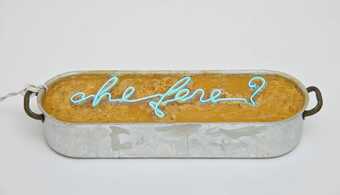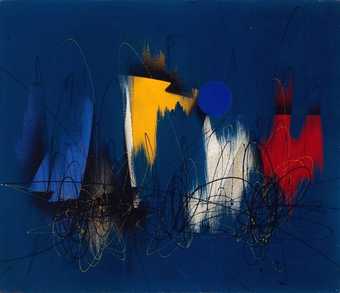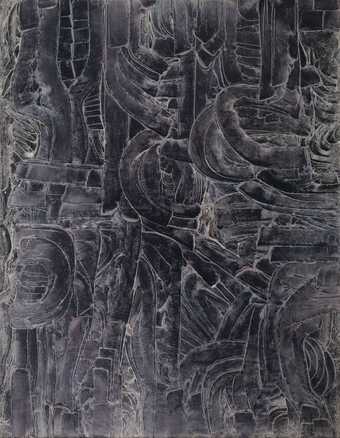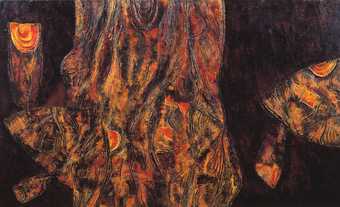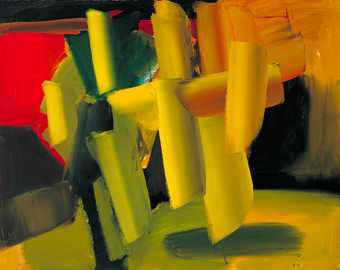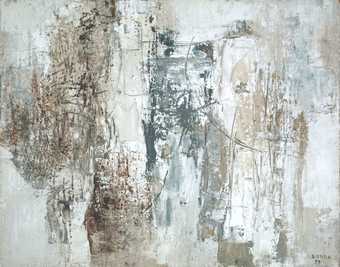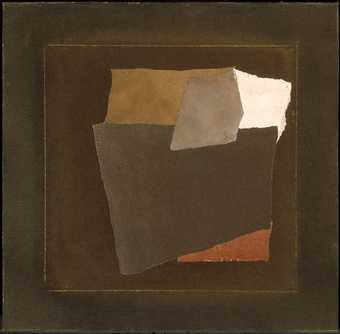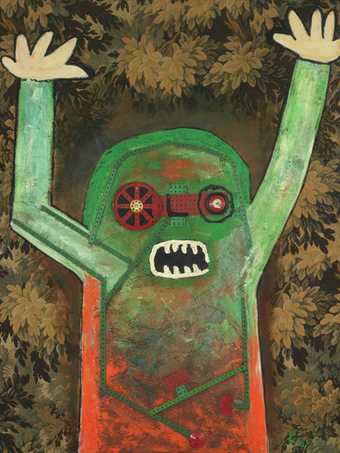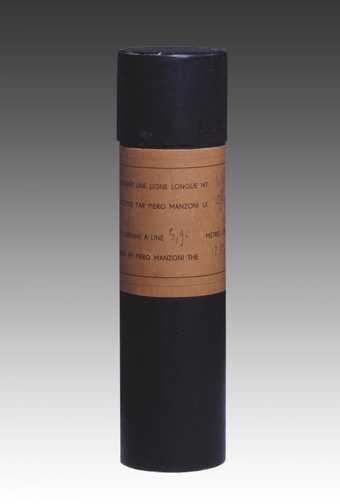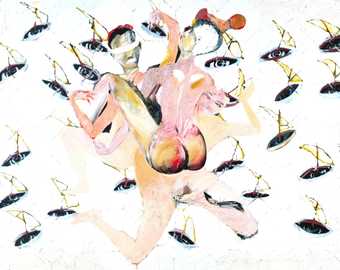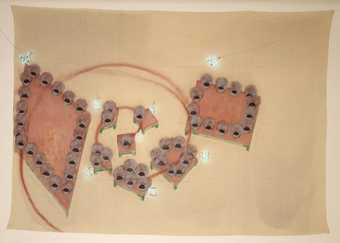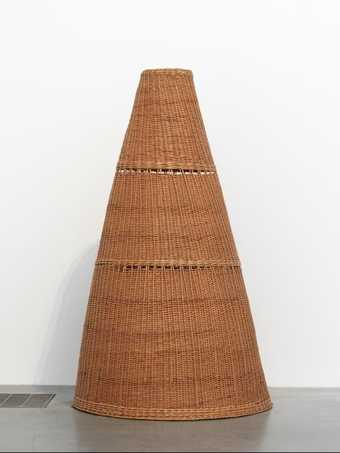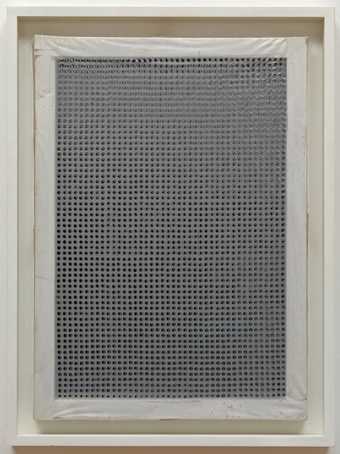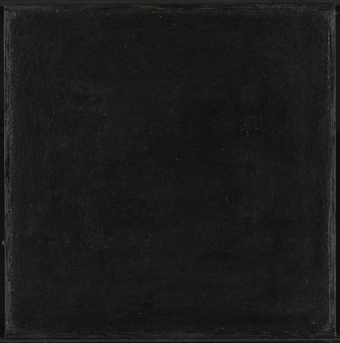
In Tate Modern
In the Studio
Free- Artist
- Piero Manzoni 1933–1963
- Medium
- China-clay on canvas
- Dimensions
- Unconfirmed: 1003 × 1003 mm
frame: 1163 × 1165 × 68 mm - Collection
- Tate
- Acquisition
- Purchased 1974
- Reference
- T01871
Summary
Achrome is a one metre square, monochromatic artwork made of china-clay on canvas by the Italian artist Piero Manzoni. This painting-like object consists of canvas squares which have been soaked in kaolin, a specialist china clay used in the making of porcelain. The rough and uneven surface reveals the folds and wrinkles formed in the canvas as it sagged under the weight of the wet clay and hardened into irregular rigid folds. The complete absence of colour acts to focus the viewer’s attention on the material qualities of the object’s surface.
The work was made by Manzoni in 1958 while he was living in Milan. He made Achrome by soaking the canvas in china clay rather than applying it directly by hand. Wrinkles and creases that developed in the process of making and drying were allowed to set without any physical intervention from the artist. Manzoni coined the term ‘achrome’ to indicate the absence of colour, or what might be termed ‘uncolour’. His aim was not to achieve a pure white but rather a total absence of colour. He gave the title Achrome to all of the white works he made from 1957 until his death in 1963.
Manzoni wanted to rid painting of narrative content, and for him this involved removing colour from his works. The absence of colour, coupled with working methods that removed the need for any gesture or action, allowed Manzoni to further his aim of creating an artwork that was without content beyond its immediate materiality. In his Achromes Manzoni brought together an interest in the artist as anti-expressionist and in the materiality of the art object. He insisted that:
We absolutely cannot consider the picture as a space on to which to project our mental scenography. It is the area of freedom in which we search for the discovery of our first images. Images which are as absolute as possible, which cannot be valued for that which they record, explain and express, but only for that which they are: to be.
(Quoted in Celant 1998, pp.55–6.)
Lucio Fontana, who had published his ‘Manifesto Blanco’ (‘White Manifesto’) in 1946, was an influential artist for Manzoni. Fontana was a familiar figure in the small Italian town of Abisola where Manzoni spent summers with his family, and he regularly encountered the older artist. Early in 1957 Manzoni visited two exhibitions in Milan that were also to become important for the development of his ideas: Proposte monochrome. Epoca blu by Yves Klein at the Galleria Apollinaire, and an exhibition of work by Alberto Burri at Galleria del Naviglio. Manzoni began making his Achromes the same year. In January 1960 he would formulate his thoughts in a text entitled ‘Free Dimension’. In this Manzoni wrote:
My intention is to present a completely white surface (or better still, an absolutely colourless or neutral one) beyond all pictorial phenomena, all intervention alien to the sense of the surface. A white surface which is neither a polar landscape, nor an evocative or beautiful subject, nor even a sensation, a symbol or anything else: but a white surface which is nothing other than a colourless surface, or even a surface which quite simply ‘is’.
(Quoted in Harrison and Wood 2003, pp.723–4.)
In later years the Achromes were made with colourless materials such as cotton, felt, fibreglass and polystyrene, which were adhered to a board but otherwise untransformed. For instance, Achrome 1960 (Herning Museum of Contemporary Art, Herning), is made from cotton wool squares. In these works, as critic and curator Germano Celant has observed, ‘even the transformation process is reduced to nothing: Manzoni chose his “achromatic” material and displayed its capacity for visual self-determination’ (Germano Celant, ‘Piero Manzoni: The Body Infinite’, in Celant 1998, p.27.)
Further reading
Germano Celant (ed.), Piero Manzoni, exhibition catalogue, Serpentine Gallery, London 1998, pp.41–4, 52–109.
Charles Harrison and Paul Wood (eds.), Art in Theory 1900–2000: An Anthology of Changing Ideas, Oxford 2003, pp.722–4.
Martin Engler (ed.), Piero Manzoni: When Bodies Became Art, exhibition catalogue, Städel Museum, Frankfurt 2013, pp.49–63, 103–39.
Beth Williamson
May 2016
Supported by Christie’s.
Does this text contain inaccurate information or language that you feel we should improve or change? We would like to hear from you.
Display caption
Manzoni aimed to strip any type of storytelling from painting. For him, this meant removing colour from his works. In 1957, he began to produce painting-like objects he called 'Achromes.' He made them by soaking his canvases in kaolin, a soft clay used to make porcelain. The kaolin removed any colour, creating ‘nothingness’. The weight of the material caused it to sag, creating folds across the surface of the canvas. He described them as 'a white surface which is neither a polar landscape, nor an evocative or beautiful subject, nor even a sensation, a symbol or anything else: but a white surface which is nothing other than a colourless surface, or even a surface which quite simply ‘is’.’
Gallery label, August 2020
Does this text contain inaccurate information or language that you feel we should improve or change? We would like to hear from you.
Catalogue entry
Piero Manzoni 1933-1963
T01871 Achrome
1958
Inscribed 'PIERO MANZONI 58'on stretcher
China-clay on canvas in squares, 39 1/2 x 39 1/2 (100.3 x 100.3)
Purchased from the Onnasch Galerie (Grant-in-Aid) 1974
Prov:
With Galleria Notizie, Turin; with Galerie Mathias Fels, Paris; with Onnasch Galerie, Cologne
Exh:
Piero Manzoni 1933-1963, Galerie Mathias Fels, Paris, December 1969-January 1970 (works not listed); Piero Manzoni 1933-1963, Städtische Galerie im Lenbachhaus, Munich, October-November 1973 (10); Kunsthalle, Tübingen, January-February 1974 (10); Piero Manzoni: Paintings, Reliefs and Objects, Tate Gallery, March-May 1974 (22)
Lit:
Germano Celant, Piero Manzoni: Catalogo Generale
(Milan 1975), p.116 repr.
Manzoni began to give his white paintings the title 'Achromes' in the autumn of 1957 to emphasise that he was concerned with 'rendering a surface completely white (integrally colourless and neutral) far beyond any pictorial phenomenon or any intervention extraneous to the value of the surface. A white that is not a polar landscape, not a material in evolution or a beautiful material, not a sensation or a symbol or anything else: just a white surface that is simply a white surface and nothing else (a colourless surface that is just a colourless surface). Better than that: a surface that simply is: to be (to be complete and become pure)' (P. Manzoni, 'Libera Dimensione' in Azimuth, No.2, 1960).
His first 'Achromes' were made with rough gesso which was scratched and marked, or with irregular rectangles of canvas impregnated with china-clay and glue, but this one comes from a slightly later series, begun in 1958, formed from regular squares of canvas. Some of his later 'Achromes' made in 1959 had seams made by machine stitching, while in 1960 he began to make a number in cotton wool and expanded polystyrene.
Published in:
Ronald Alley, Catalogue of the Tate Gallery's Collection of Modern Art other than Works by British Artists, Tate Gallery and Sotheby Parke-Bernet, London 1981, pp.478-9, reproduced p.478
Explore
- abstraction(8,615)
-
- non-representational(6,161)
-
- monochromatic(722)
- formal qualities(12,454)
- void(34)
You might like
-
Mario Merz Che Fare?
1968–73 -
Roberto Crippa Aurora Borealis
1952 -
Jack Clemente Mineral Efflorescence
1958 -
Jack Clemente Volcanic City
1957 -
Alfredo Chighine Composition with Palm Trees
1960 -
Mario Bionda Forms on a White Background
1958 -
Italo Valenti Palestrina
1963 -
Enrico Baj Fire! Fire!
1963–4 -
Piero Manzoni Line 4.90m, December 1959
1959 -
Francesco Clemente Midnight Sun II
1982 -
Mario Merz Fibonacci Tables
1974–6 -
Mario Merz Cone
c.1967 -
Mimmo Rotella With a Smile
1962 -
Dadamaino Volume of Displaced Modules
1960 -
Art & Language (Mel Ramsden) Two Black Squares
1965

